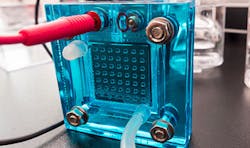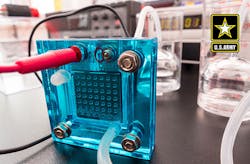Modern military electronic systems require reliable sources of power, in both fixed and mobile operations, and the U. S. Army Research Office is looking to artificial intelligence (AI) for help. More specifically, this part of the Army Research Laboratory (ARL) is hoping to develop more efficient fuel cells by combining novel materials with machine-learning techniques. Through the funding of researchers at Cornell University (see figure), different elements are being combined through simulations to find a material mix that will lead to better batteries.
The U.S. Army Research Office is working with researchers at Cornell University to apply AI in replacing hydrogen with methanol to create more-efficient fuel cells. (Courtesy of Army Research Laboratory)
“The exciting part about basic science research is you can't always predict where the results will lead,” says Dr. Purush Iyer, division chief, network sciences at the Army Research Office, an element of the U.S. Army Combat Capabilities Development Command's ARL. “We funded this research to better understand collective intelligence (wisdom of crowds). While material science applications, such as design of novel alloys, were always in the cards, the serendipitous nature of the eventual outcome, that of a catalyst to aid in designing better fuel cells, is solving a problem of immense importance for the Army—battery power in the field—shows the importance of investing in basic research.”
To find those useful new materials from so many potential combinations, the researchers have relied on the processing power of modern computer systems working with AI technology. According to Cornell’s Dr. Carla Gomes, professor of computer science and director of the Institute for Computational Sustainability, “It really pushes the frontier of AI to derive physically meaningful solutions.”
The researchers are seeking to improve vehicular fuel cells by searching for a catalyst that would allow them to replace difficult-to-store hydrogen with methanol to form more-efficient fuel cells. As part of a system named CRYSTAL, after the crystal structure or phase of different materials, the team is seeking optimum material combinations for next-generation fuel cells.
About the Author
Jack Browne
Technical Contributor
Jack Browne, Technical Contributor, has worked in technical publishing for over 30 years. He managed the content and production of three technical journals while at the American Institute of Physics, including Medical Physics and the Journal of Vacuum Science & Technology. He has been a Publisher and Editor for Penton Media, started the firm’s Wireless Symposium & Exhibition trade show in 1993, and currently serves as Technical Contributor for that company's Microwaves & RF magazine. Browne, who holds a BS in Mathematics from City College of New York and BA degrees in English and Philosophy from Fordham University, is a member of the IEEE.


